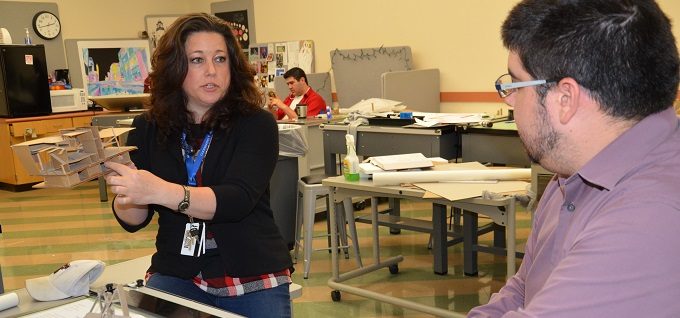Architecture of a successful program
By Michael Bratten
January 4, 2017
With enrollment climbing, the architecture and drafting technology program at a Texas college is running out of room.
A U.S. Navy veteran with 25 years of service, Angela Muhammad is working toward a new career that’s close to her heart: Building affordable homes for single parents and the elderly.
“I’ve done missionary work and I’ve seen how we have a deficiency in clean, safe, affordable housing,” said Muhammad, 50, a second-year student in Del Mar College’s architecture/drafting technology program. “I’ve always had an interest in how things are built.
“There’s a need for this program,” she continued, taking a break in the architectural design studio, where she’s using glue and chipboard to make a small model of a building. “I’ve seen a lot of growth over the past two years. I think the instructors are invested in it.”
Muhammad is thriving in a program that is growing beyond expectations. Enrollment in the architecture/drafting technology program nearly tripled between fall 2011 and fall 2016, from 105 to 294 students, respectively.
If the program has a proud mom, it’s Laura Wright, interim chair of technology education, assistant professor and program coordinator of architecture/drafting technology. She began teaching at the Texas college in 2011, and the changes she and her colleagues implemented since then have created a perfect enrollment storm and a bridge to a full-fledged architecture degree for local students.
“All we had before were some architectural design courses that didn’t transfer,” said Wright, who, through committee memberships with the Texas Higher Education Coordinating Board and the Texas Society of Architects, is intimately familiar with architectural education and curriculum. “We revamped the curriculum and made a program that could transfer into a university-level architecture program.”
Thanks to a 2013 agreement, students can now take the first two years of their architecture education at Del Mar and transfer to Texas Tech University in Lubbock to complete their degree — typically three more years. And students at two local high schools can get a head start through dual credit arrangements with Del Mar.
Workforce outlet
In revamping curriculum, Wright said it was also important to provide a “workforce outlet” — in other words, offer programs for students who want to gain marketable job skills and enter the workforce quickly, rather than pursue a four-year degree or higher.
In 12 months, for example, students can earn a certificate in computer-aided drafting, pipe drafting and design technology or digital design and fabrication. In two years, they can graduate with an associate degree in architectural design, technical drafting or construction technology.
Graduation is another area that receives bird-dog attention from Wright and her team. In the past, some students had difficulty completing courses and graduating because classes they needed didn’t have enough students enrolled to commence, she said.
To alleviate the problem, instructors tailor curriculum schedules and play a key role in advising. The result is a nearly 70-percent increase in program graduates between the 2011-12 and 2015-16 academic years.
“We have a lot of overlap of classes,” Wright said. “If the student decides, ‘I like design but I don’t like this or that,’ they can move into another discipline easily. Their classes still count and they have found their niche in the industry. That’s part of good advising.”
Collaborative environment
After attending Del Mar “on and off” since 2010, Sherry McCleese zeroed in on the architecture/drafting technology program as her pathway to a career as an interior designer.
“Right now, I’m focused on graduating and transferring to a university,” said McCleese, 27. “This isn’t like being in a typical classroom. It’s a very collaborative environment. I feel like it’s preparing us to work with others in a professional setting.”
“One of the things we focus on is real life soft skills,” Wright said. “Not only are students getting aspects of design in their education, they’re also learning communication, management, team building and critical thinking skills, which can be applied in their profession and practice.”
They’re learning outside the classroom, too.
Through partnerships with local non-profit organizations, students can participate in community service projects that complement their studies. Once a month, they help build homes with Habitat for Humanity, and students in the technical animation and rendering class are creating three-dimensional images of an historic local theater, The Ritz, to help in a restoration effort.
There’s more to the story. Read the full article in Community College Daily.



